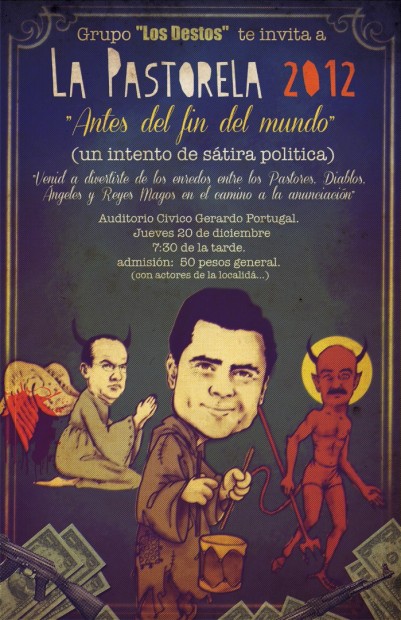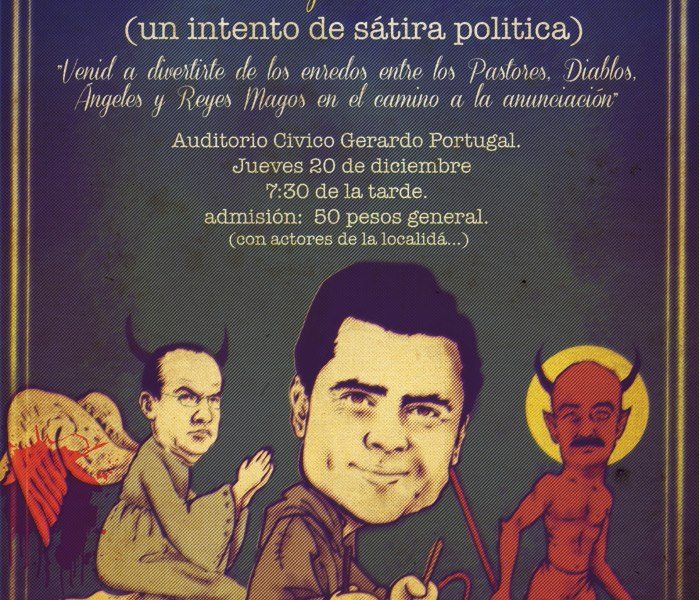By MoKa Hammeken
During these December holidays, in addition to the posadas, pastorelas are also very much in vogue. Here in Puerto Peñasco various luminaries from the cultural sphere are going to present their own traditional pastorela on Thursday, Dec. 20th at the Municipal Auditorium entitled “Before the end of the world (an attempt at political satire).” (7:30 p.m., 50 pesos/person)
 Pastorelas are traditional comic representations in December that in essence deal with the birth and adoration of Baby Jesus, though Joseph, Mary and Jesus are seldom personified. These plays were created during the period of evangelization and are among the popular religious theater forms Mexico inherited from Spain. The friars would teach the indigenous populations through theater, facilitating the task of indoctrination in their faith as language barriers were often extensive. In addition, as indigenous populations enjoyed the representations that were also common within their own religious practices, it wasn’t difficult to insert liturgical drama. Nevertheless, as opposed to the posadas, the origins of pastorelas are not exclusively Mexican as pastoral theater (hence the name pastorela) was born in Italy (much the same way it was done centuries later in Mexico) thanks to the Franciscan monks.
Pastorelas are traditional comic representations in December that in essence deal with the birth and adoration of Baby Jesus, though Joseph, Mary and Jesus are seldom personified. These plays were created during the period of evangelization and are among the popular religious theater forms Mexico inherited from Spain. The friars would teach the indigenous populations through theater, facilitating the task of indoctrination in their faith as language barriers were often extensive. In addition, as indigenous populations enjoyed the representations that were also common within their own religious practices, it wasn’t difficult to insert liturgical drama. Nevertheless, as opposed to the posadas, the origins of pastorelas are not exclusively Mexican as pastoral theater (hence the name pastorela) was born in Italy (much the same way it was done centuries later in Mexico) thanks to the Franciscan monks.
Armando de María y Campos, author of the work Pastorelas Mexicanas: su origin, historia y tradición (Mexican Pastorelas: their origin, history, and tradition) also affirms the first of these representations within Mexican territory took place in 1533 in Santiago de Tlatelolco, with the pastorela entitled “The end of the world” (which curiously is the name of the pastorela to be presented by actors from the theater group “Destos” here in Puerto Peñasco this Thursday).
In Mexico, the pastorela soon experienced indigenous influence and elements of a new identity that through time transformed the representation, converting it into what has now become more solemn and more comical. This came about as authors would create compositions adhering less so to tradition; as these became accepted they grew to incorporate common situations that frequently poke fun at political figures (and religious at times) such as the society of aristocrats.
This was the structure used by José Joaquín Fernández de Lizardi for his famous pastorela “La Noche más Venturosa” (The most adventurous night), written in 1821 that became a classic. The basic argument consists of shepherds trying to go to Bethlehem to adore the newborn Baby Jesus, however a group of devils puts a number of obstacles in their way, impeding their travels. This structure is similar to that used in pastorelas today however the drama behind the journey stems from each author, their creativity and keen perception. That is why though pastorelas may seem similar, they are each an original and never the same.
Pastorelas…y antes del fin del mundo
Por MoKa Hammeken
En estas fechas decembrinas, aparte de las posadas, están muy en boga las pastorelas gracias a que en Puerto Peñasco que algunas luminarias del ámbito cultural van a presentar una el 20 de diciembre en el Auditorio Municipal llamada “Antes del fin del mundo (un intento de sátira política)”. (7:30 p.m., entrada: 50 pesos)
Es son representaciones escénicas cómicas tradicionales de diciembre que tratan del nacimiento y adoración al Niño Jesús y aunque ellos, María, José y el Niño Jesús, son la razón principal, pocas veces son personificados
Estas fueron creadas a partir de la evangelización y es una de las formas de teatro popular religioso que heredamos de España.
Así, con el teatro, era que los frailes enseñaban a los nativos, pues les facilitaba la tarea de adoctrinarlos en la fe siendo que muchas veces la barrera del lenguaje era amplia y que los indígenas aparte disfrutaban mucho de las representaciones (eran también comunes en sus prácticas religiosas) , entonces no les fue muy difícil implantar el drama litúrgico. Sin embargo, a diferencia de las posadas, estas no son de origen exclusivamente mexicano, pues el teatro pastoral (de ahí el nombre pastorela), nace en Italia (al igual que siglos más tarde en México) gracias a los franciscanos
Armando De María y Campos, autor de la obra Pastorelas mexicanas: su origen, historia y tradición, afirma también que la primera de las representaciones de que se tienen noticias en territorio mexicano aconteció en 1533 en Santiago de Tlatelolco, con la pastorela “El fin del mundo” (curioso es que ahora los actores del grupo “Destos” aquí en Peñasco presenten uno con nombre similar) .
Entonces, en México la pastorela pronto experimentó influencias indígenas y elementos de una nueva identidad, que con el paso del tiempo, transformó esta representación hasta convertirla en propia, siendo ahora más de carácter menos solemne y más cómico y esto se dio conforme los autores profanos hacían composiciones menos apegadas a la tradición, y siendo bien aceptados se incluía cada vez con mayor frecuencia contenido de situaciones populares en los que se burlan tanto de las autoridades políticas (y en ocasiones hasta religiosas) como de la sociedad aristocrática. Ésta es la estructura que usó José Joaquín Fernández de Lizardi para su famosa pastorela “La Noche más Venturosa”, escrita en 1821 y que se volvió un clásico.
El argumento básico consiste en que unos pastores intentan ir a Belén para adorar al Niño Dios recién nacido, pero un grupo de diablos pone toda clase de obstáculos en su camino para impedirlo, muy similar a la estructura que se usa hoy en día, sin embargo ya la trama ya es cuento de cada autor, su creatividad y agudeza.
Y es por eso que aunque muchas se parezcan, si son originales, nunca son iguales.
